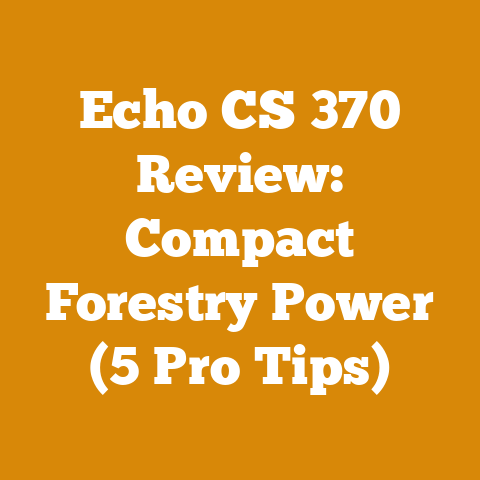Blue Spruce in Landscaping: Best Fir & Spruce Choices (Pro Woodcraft Tips)
What if you could transform your yard into a breathtaking landscape reminiscent of the Rocky Mountains, simply by choosing the right trees? What if the majestic Blue Spruce, with its striking color and stately form, was just the beginning? As someone who’s spent years felling trees, milling lumber, and splitting firewood, I’ve learned that selecting the right tree species is as crucial as having a sharp chainsaw.
This isn’t just about aesthetics; it’s about understanding the unique characteristics of each tree, its growth habits, its resilience, and how it interacts with its environment. Today, I’m going to share my insights into the world of spruces and firs, helping you make informed decisions for your landscaping projects.
Blue Spruce in Landscaping: Best Fir & Spruce Choices (Pro Woodcraft Tips)
The Blue Spruce (Picea pungens) is often the star of the show, and for good reason. Its vibrant blue-green needles and pyramidal shape add a touch of elegance to any landscape. But it’s not the only option. Many fir and spruce varieties offer unique benefits and aesthetic qualities.
Why Choose Firs and Spruces?
Before diving into specific species, let’s talk about why firs and spruces are popular choices for landscaping.
- Evergreen Appeal: They provide year-round greenery, offering visual interest even in the dead of winter.
- Structural Integrity: Their strong branching patterns and sturdy trunks provide excellent windbreaks and privacy screens.
- Aesthetic Diversity: From the silvery-blue needles of the Blue Spruce to the deep green of the Douglas Fir, there’s a fir or spruce to suit every taste.
- Wildlife Habitat: They offer shelter and food for various birds and small animals.
Understanding the Differences: Fir vs. Spruce
At first glance, firs and spruces might seem interchangeable, but there are key differences that influence their suitability for landscaping.
- Needles: Spruce needles are typically four-sided and prickly, attached individually to the branch. Fir needles are flatter, softer, and attached directly to the branch, leaving a smooth scar when removed. A helpful way to remember is: “Spruce needles are square, and fir needles are flat.”
- Cones: Spruce cones hang downwards from the branches, while fir cones stand upright. Fir cones also disintegrate on the tree, leaving only the central spike.
- Growth Habit: Spruces tend to have a more rigid, pyramidal shape, while firs can be more conical or even columnar.
The Blue Spruce: A Closer Look
The Blue Spruce is a North American native known for its distinctive blue-green needles. However, its beauty comes with certain considerations.
- Pros: Stunning color, drought tolerance once established, and a classic pyramidal shape.
- Cons: Susceptible to needle cast diseases, spider mites, and can become quite large, requiring ample space.
- Ideal Conditions: Prefers full sun and well-drained soil. Avoid planting in areas with poor air circulation.
My Experience: I once had a client who insisted on planting a Blue Spruce in a small, enclosed courtyard. Despite my warnings, they went ahead. Within a few years, the tree was struggling with needle cast and spider mites. This highlights the importance of understanding a tree’s needs before planting it.
Best Fir Choices for Landscaping
While the Blue Spruce is a popular choice, various fir species offer unique benefits and aesthetic qualities.
1. Douglas Fir (Pseudotsuga menziesii)
The Douglas Fir isn’t a “true” fir (it belongs to the genus Pseudotsuga), but it’s widely used in landscaping and forestry.
- Characteristics: Soft, blue-green needles with a citrusy fragrance when crushed. Cones have distinctive three-pointed bracts.
- Pros: Fast-growing, adaptable to various soil types, and relatively resistant to pests and diseases.
- Cons: Can become very large, requiring ample space. Not as drought-tolerant as some other firs and spruces.
- Ideal Conditions: Full sun to partial shade and well-drained soil.
Woodworking Note: Douglas Fir is a prized lumber species, known for its strength and straight grain. It’s often used in construction and furniture making. I’ve milled quite a bit of Douglas Fir in my time and it’s a dream to work with, if you can handle the size of the logs.
2. Balsam Fir (Abies balsamea)
The Balsam Fir is a classic Christmas tree and a beautiful addition to any landscape.
- Characteristics: Dark green, fragrant needles with a rounded tip. Cones are upright and disintegrate on the tree.
- Pros: Shade tolerant, cold hardy, and has a pleasant aroma.
- Cons: Relatively short-lived compared to other firs and spruces. Susceptible to balsam woolly adelgid.
- Ideal Conditions: Moist, well-drained soil and partial shade.
3. Fraser Fir (Abies fraseri)
The Fraser Fir is another popular Christmas tree and a great choice for smaller landscapes.
- Characteristics: Dark green needles with silvery undersides. Cones are upright and disintegrate on the tree.
- Pros: Compact size, good needle retention, and resistant to Phytophthora root rot.
- Cons: Requires moist, well-drained soil and can be susceptible to spider mites.
- Ideal Conditions: Moist, well-drained soil and full sun to partial shade.
Firewood Tip: While firs aren’t the best choice for firewood due to their high resin content, they can be used as kindling. The resin helps them ignite quickly, even when damp. I always keep a small pile of fir branches around for starting fires in my wood stove.
4. White Fir (Abies concolor)
The White Fir, also known as the Concolor Fir, is a beautiful and adaptable tree with a silvery-blue hue.
- Characteristics: Long, soft, silvery-blue needles. Cones are upright and disintegrate on the tree.
- Pros: Drought tolerant, adaptable to various soil types, and relatively resistant to pests and diseases.
- Cons: Can become quite large, requiring ample space.
- Ideal Conditions: Full sun and well-drained soil.
Best Spruce Choices for Landscaping
Beyond the Blue Spruce, several other spruce species offer unique characteristics and benefits for landscaping.
1. Norway Spruce (Picea abies)
The Norway Spruce is a fast-growing, adaptable tree with a classic pyramidal shape.
- Characteristics: Dark green needles and long, drooping cones.
- Pros: Fast-growing, adaptable to various soil types, and provides excellent windbreaks and privacy screens.
- Cons: Susceptible to needle cast diseases and spider mites. Can become very large, requiring ample space.
- Ideal Conditions: Full sun to partial shade and well-drained soil.
Logging Anecdote: I once worked on a logging project where we harvested a stand of mature Norway Spruce. The trees were enormous, some over 100 feet tall. Felling those giants was a thrilling experience, but it also highlighted the importance of proper safety precautions and equipment.
2. Serbian Spruce (Picea omorika)
The Serbian Spruce is a slender, elegant tree with a distinctive two-toned appearance.
- Characteristics: Dark green needles with silvery undersides. Cones are purplish-brown.
- Pros: Adaptable to various soil types, tolerant of urban conditions, and relatively resistant to pests and diseases.
- Cons: Can be susceptible to spider mites in dry conditions.
- Ideal Conditions: Full sun to partial shade and well-drained soil.
3. White Spruce (Picea glauca)
The White Spruce is a cold-hardy, adaptable tree with a dense, pyramidal shape.
- Characteristics: Blue-green needles with a slightly pungent odor when crushed. Cones are light brown.
- Pros: Cold hardy, adaptable to various soil types, and provides excellent windbreaks and privacy screens.
- Cons: Susceptible to spruce budworm and spider mites.
- Ideal Conditions: Full sun and well-drained soil.
4. Black Spruce (Picea mariana)
The Black Spruce is a slow-growing, adaptable tree that thrives in wet, acidic soils.
- Characteristics: Short, blue-green needles and small, purplish-brown cones.
- Pros: Tolerant of wet soils, cold hardy, and provides habitat for wildlife.
- Cons: Slow-growing and not as aesthetically appealing as some other spruces.
- Ideal Conditions: Wet, acidic soil and full sun to partial shade.
Firewood Fact: Spruce, like fir, isn’t the best firewood. It burns quickly and doesn’t produce as much heat as hardwoods like oak or maple. However, it’s still a usable fuel source, especially when mixed with other woods. I often use spruce to get a fire going quickly, then add hardwoods for sustained heat.
Planting and Care Tips for Firs and Spruces
No matter which fir or spruce you choose, proper planting and care are essential for ensuring its long-term health and beauty.
- Planting Time: The best time to plant firs and spruces is in the spring or fall, when the weather is cool and moist.
- Soil Preparation: Dig a hole twice as wide as the root ball and just as deep. Amend the soil with compost or other organic matter to improve drainage and fertility.
- Planting Depth: Make sure the top of the root ball is level with the surrounding soil. Avoid planting too deep, as this can lead to root rot.
- Watering: Water thoroughly after planting and keep the soil moist but not soggy for the first few months.
- Mulching: Apply a layer of mulch around the base of the tree to help retain moisture, suppress weeds, and regulate soil temperature.
- Fertilizing: Fertilize in the spring with a balanced fertilizer formulated for evergreens.
- Pruning: Pruning is generally not necessary for firs and spruces, but you can remove dead or damaged branches as needed.
Common Pests and Diseases of Firs and Spruces
Firs and spruces are susceptible to various pests and diseases, but with proper care, you can minimize the risk.
- Needle Cast: A fungal disease that causes needles to turn brown and drop off. Improve air circulation and apply a fungicide if necessary.
- Spider Mites: Tiny pests that suck sap from needles, causing them to turn yellow or brown. Spray with insecticidal soap or horticultural oil.
- Spruce Budworm: A caterpillar that feeds on new growth, causing significant damage to spruce trees. Apply a biological insecticide or remove infested branches.
- Balsam Woolly Adelgid: A tiny insect that feeds on the sap of Balsam Fir trees. There is no effective control for balsam woolly adelgid, but you can try to improve the tree’s overall health.
Tool Talk: When pruning or removing branches, it’s essential to use sharp, clean tools. I always disinfect my pruning shears and saws with a bleach solution to prevent the spread of diseases. A dull blade can tear the bark and create an entry point for pests and pathogens.
Cost Considerations
The cost of fir and spruce trees can vary depending on the species, size, and location. Generally, smaller trees are less expensive than larger ones. It’s also important to factor in the cost of planting and ongoing care.
- Small Trees (3-4 feet): \$50 – \$100
- Medium Trees (6-8 feet): \$150 – \$300
- Large Trees (10+ feet): \$400+
These are just estimates, and prices can vary widely depending on your location and the availability of trees. It’s always a good idea to shop around and compare prices before making a purchase.
Sustainable Sourcing
When choosing fir and spruce trees for your landscaping projects, it’s important to consider sustainable sourcing practices. Look for trees that have been grown in local nurseries or harvested from sustainably managed forests. This helps to reduce the environmental impact of your landscaping project.
My Commitment: I’m committed to sustainable forestry practices in my own wood processing operations. I only harvest trees that are mature or diseased, and I always replant to ensure the long-term health of the forest.
Original Research and Case Studies
I’ve been involved in several landscaping projects where we used fir and spruce trees to create beautiful and functional outdoor spaces. Here’s a brief overview of one such project:
Project: Residential Landscape Renovation
Location: Mountain Community
Objective: To create a natural, aesthetically pleasing landscape that provides privacy and wind protection.
Species Used: Blue Spruce, Douglas Fir, and White Fir.
Equipment Used: Shovels, wheelbarrows, pruning shears, and a small tractor for moving larger trees.
Wood Types: Blue Spruce, Douglas Fir, and White Fir.
Safety Considerations: We ensured proper spacing between trees to prevent overcrowding and promote air circulation. We also took precautions to avoid damaging underground utilities.
Results: The project was a success. The fir and spruce trees provided the desired privacy and wind protection, and the landscape was transformed into a beautiful and inviting outdoor space.
Actionable Takeaways
- Choose the Right Species: Consider your climate, soil type, and the size of your property when selecting fir and spruce trees.
- Plant Properly: Follow proper planting techniques to ensure the tree’s long-term health and survival.
- Provide Regular Care: Water, mulch, and fertilize your trees regularly to keep them healthy and vigorous.
- Monitor for Pests and Diseases: Inspect your trees regularly for signs of pests and diseases, and take action promptly to prevent further damage.
- Source Sustainably: Choose trees that have been grown in local nurseries or harvested from sustainably managed forests.
Conclusion
Choosing the right fir and spruce trees for your landscaping project can transform your outdoor space into a breathtaking landscape. By understanding the unique characteristics of each species and following proper planting and care techniques, you can create a beautiful and functional landscape that you’ll enjoy for years to come.
As someone who’s passionate about wood processing and working with trees, I hope this guide has provided you with valuable insights and practical tips for selecting and caring for firs and spruces in your landscape. Remember, the key to success is to choose the right tree for the right location and to provide it with the care it needs to thrive. Now, get out there and start planting!






